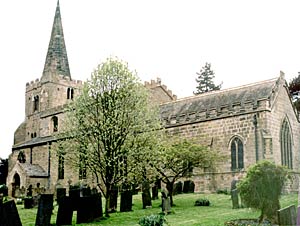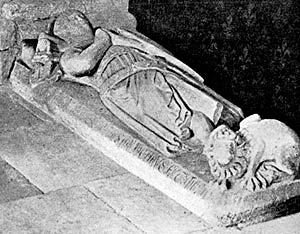< Previous | Contents | Next >
Good News from the Grange
LOWDHAM. We should come to Lowdham in springtime for the glory of the orchard blossom on the hillside, when the wayside nurseries are ablaze with all the colours of the rainbow, when the churchyard (trim and peaceful in a lovely hollow) is spangled with primroses and the lime avenue leading to the old Hall is aglow with daffodils.

Lowdham church in 2002.
The loveliest corner of the village, growing round its busy crossroads, is where the church stands at the end of a little-frequented byway. With a brook flowing through the quiet dingle, and a background of woods, it is a beautiful picture outside, its 15th century spire crowning a sturdy tower built when the Norman style was passing. Inside it is full of light streaming through charming windows which are for the most part renewed, though the clerestory is 15th century.
The 13th century arcades have stone seats at the foot of their slender clustered pillars. The two bays between the chancel and its chapel are from the time of King John. The fine font is 14th century, a small altar table is Jacobean, and a studded oak door made in 1641 swings in the south doorway, which has a small consecration cross.

Effigy of Sir John de Lowdham, c.1907.
Lying in the chancel he founded in the 14th century is a cross-legged knight, Sir John de Lowdham, wearing chain mail and with a shield. The chancel was made new last century; on its south wall is a stone with the fine engraved figure of a 15th century priest in his robes.
Two interesting things we learn about Lowdham. One is that Cornelius Brown, a county historian, was born here in the middle of last century; the other is that Lowdham Grange has become the scene of an experiment for making bad lads into good citizens. It was about 1930 when a group of boys was marching from a Borstal Institution in Kent to this farmhouse in Notts, some of them thieves, some burglars, some violent young ruffians, but all on their honour to march to Lowdham Grange. They arrived here after nine days, living first in tents on the lawn, then in huts, and now in fine school buildings, built round the old farm. Neither by night nor day does the lock turn on them. Of 500 boys chosen at Wormwood Scrubs to come here only 52 have run away, and 50 came back. Of about 300 who had left Lowdham when we called fewer than 20 had been at their old tricks again, and it may be said that Lowdham Grange has become a notable landmark in the transformation of bad humanity into good.
